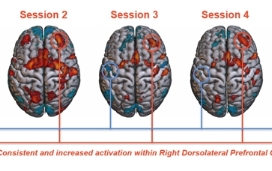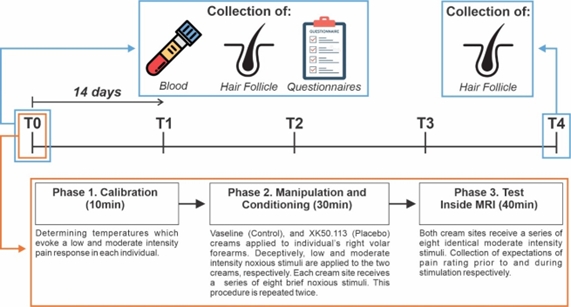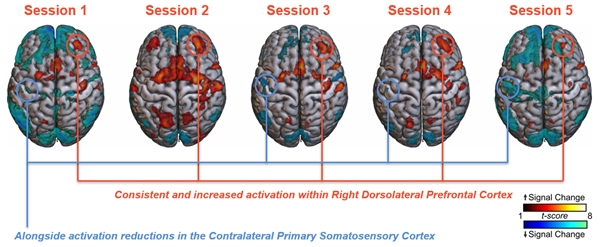
RESEARCH SPOTLIGHT: Needles in a haystack – searching for a consistent placebo analgesia responder
We know that many people can experience placebo analgesia – but are these responses stable over time? Borrowing from the designs of longitudinal preclinical investigations, researchers at NeuRA, led by Professors Luke Henderson and Kevin Keay, have recently completed preliminary data collection investigating the consistency of placebo analgesia, combining genetic, behavioural, biological, and brain imaging data.

by Lewis Crawford, Damien Boorman, Kevin Keay, and Luke Henderson
Pain is a puzzle, but the human ability to control pain is an enigma. Over the past two decades, we have begun to unravel the neural circuitry, psychophysiological underpinnings, and genetic factors that lead to our ability to mount placebo analgesia – the pain-modulatory phenomenon whereby the administration of a pharmacologically inert substance can provide powerful pain relief by virtue of expectations or the context surrounding the administration of that substance.
Less understood, however, is how stable this phenomenon is across time. That is to say, is a person who shows a strong placebo analgesic response in one session likely to continue reproducing that response if they are kept unaware that they are receiving a placebo? Resolving this gap in the literature presents a monumental step in the broader integration of the qualities that allow a person to show stronger placebo analgesia being brought into clinical practice.
More than that, if we can (with reasonable accuracy) predict who is likely to show a stable and significant placebo analgesia response across time, those seeking to balance placebo effects across the active and sham arms of randomized controlled trials would invariably rejoice.
Due to the breadth of factors that are believed to underlie the expression of placebo analgesia, this study combined several data streams to provide a holistic investigation of the central factors that drive this phenomenon, and which qualities of an individual lead to its consistent expression. Five experimental sessions were conducted in 2-week intervals for a total of 8 weeks, with behavioural conditioning and functional magnetic resonance imaging (fMRI) collected during each of these five sessions whilst placebo analgesia was triggered.

During the first session, participants completed questionnaires characterizing the psychological traits believed to be associated with greater placebo analgesia, and a blood sample was collected to assess participant genotypes. A single hair follicle was collected during the first and final session to assess the change in cortisol, and another questionnaire was administered during each session to assess ongoing changes in current mood prior to each specific session. During each MRI collection, we also collected a resting-state fMRI scan to assess baseline brain state and pulse and respiration were measured throughout the MRI session to relate ongoing physiological fluctuations to placebo analgesia magnitude.
At present, we have completed behavioural data analysis and identified consistent placebo analgesic responses in 50% of our cohort (10/20 participants). Within the brain, these consistent responses were associated with heightened activation in the right dorsolateral prefrontal cortex, and reduced activity in the left (contralateral) primary somatosensory cortex – closely matching the known roles of these sites in pain perception and modulation.
Our preliminary findings stand in antithesis to prior investigations suggesting that the ability to predict who will respond to a placebo administration was no more reliable than random chance. Given most single-session experiments find a significant response in 30-50% of participants, our investigation tells the story that these responders are likely stable, with the biopsychosocial composition to continue to respond to administered placebos in the future.
As we continue to analyze and integrate our multiple data streams, we intend to put the puzzle together as to what makes a consistent placebo responder.
Recent Comments